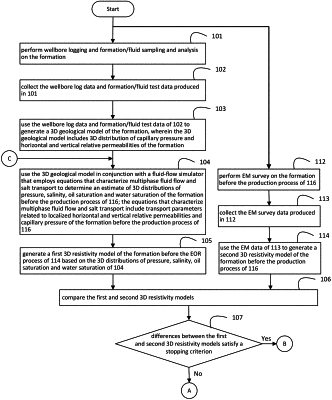| CPC G01V 99/005 (2013.01) [E21B 43/00 (2013.01); E21B 49/00 (2013.01); G01V 3/08 (2013.01); G01V 3/18 (2013.01); G01V 11/00 (2013.01); G06F 30/20 (2020.01); E21B 43/16 (2013.01); E21B 2200/20 (2020.05); G01V 2210/66 (2013.01); G06F 2113/08 (2020.01)] | 18 Claims |

|
1. A method for characterizing a subterranean formation, comprising:
i) generating a three-dimensional geological model of the formation;
ii) using the three-dimensional geological model of the formation in conjunction with a fluid-flow simulator to generate a first three-dimensional distribution of resistivity of the formation;
iii) collecting electromagnetic survey data of the formation;
iv) generating a second three-dimensional distribution of resistivity of the formation based on the electromagnetic survey data;
v) updating the three-dimensional geological model of the formation based on differences between the first and second three-dimensional distributions of resistivity of the formation;
vi) repeating the operations of ii) and v) until differences between the first and second three-dimensional distributions of resistivity of the formation satisfy a stopping criterion;
vii) storing data characterizing properties of the formation based on the three-dimensional geological model of the formation that results from vi);
vii) generating a third three-dimensional distribution of resistivity of the formation after an enhanced oil recovery process;
viii) generating a fourth three-dimensional distribution of resistivity of the formation based upon an electro-magnetic survey of the formation;
ix) calculating differences between the third and fourth three-dimensional distributions; and
x) updating the three-dimensional geological model of the formation based upon the differences.
|